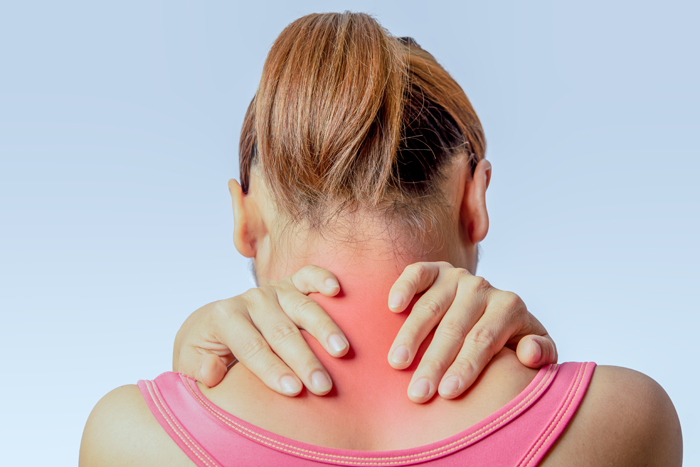Cervical Spondylosis Treatment in Chunni-ganj, Kanpur
Cervical spondylosis refers to the wear and tear that affects the spinal disks present in your neck. When these disks start to dehydrate and shrink because of age, the signs of osteoarthritis develop. This includes boney projects along with the bone spurs. It is a very common condition that gets worse with age. In most cases, there won’t be any symptoms. But, when they do occur, nonsurgical treatments might not be effective.

Symptoms
As mentioned before, in most cases, there are no symptoms for this condition. When symptoms occur, they usually include stiffness and pain in the neck. In some cases, cervical spondylosis will narrow down the space needed by the nerve roots and the spinal cord. If they become pinched, you might experience the following:
- Weakness, numbness, and tingling in your hands, arms, feet, or legs
- Difficulty walking
- Lack of coordination
- Loss of bowel and bladder control
When should you see a doctor?
If there is a sudden onset of weakness, numbness, or lack of bowel or bladder control, you should seek medical attention immediately.
Request an appointment at Apollo Spectra Hospitals, Kanpur
Call 1860-500-2244 to book an appointment
Causes
As you age, the cartilage and bone that make up your neck and backbone start to wear and tear. Here are the changes that can cause cervical spondylosis:
- Dehydrated disks - Disks are like cushions between your spine’s vertebrae. When you reach the age of 40, your spinal disks start to dry out and shrink which leads to more bone-on-bone contact among the vertebrae.
- Herniated disks - Age can also affect your spinal disks’ exterior. This can result in cracks and bulging or herniated disks that can press on the nerve roots and spinal cord.
- Bone spurs - When your disk degenerates, it causes the spine to produce extra bone to strengthen the spine. This is a misguided effort as bone spurs can pinch the nerve roots and the spinal cord.
- Stiff ligaments - Ligaments are tissue cords connecting bone to bone. With age, these can stiffen and make your neck less flexible.
Risk factors
Here are some risk factors for this condition:
- Age - It is a normal part of aging
- Neck injuries - If you have had neck injuries in the past, the risk of developing the condition is increased.
- Occupation - If you work at a job that involves awkward positioning, overhead work, or repetitive neck motions that put stress on your neck, you are at risk of cervical spondylosis.
- Smoking - Smoking can increase neck pain.
- Genetic factors - Some people will experience more changes over time while others won’t.
Complications
If cervical spondylosis is left untreated and your nerve roots or spinal cord become severely compressed, you might experience permanent damage.
Treatment
The treatment for cervical spondylosis will depend on how severe your symptoms are. This treatment aims to help you get some relief from pain. maintain your usual activities, and prevent permanent damage to the nerves and spinal cord. Here are some treatment options:
If over-the-counter medications are not enough for relieving pain, your doctor might prescribe one of the following:
By consulting a physiotherapist, you can learn exercises that help you in strengthening and stretching the muscles present in your shoulders and neck. Some people with this condition can benefit from traction that provides more space within the spine.
If nonsurgical treatments don’t work for you, you might need surgery at Apollo Spectra, Kanpur, for creating more room for your nerve roots and spinal cord. This surgery might involve:
- Medications
- Nonsteroidal anti-inflammatory drugs - This includes prescription-strength versions for relieving the inflammation and pain associated with the condition.
- Corticosteroids - A short course of these medications will help ease the pain.
- Muscle relaxants - Certain drugs can provide relief from muscle spasms.
- Anti-seizure medications - Epilepsy medications can dull the pain of nerves that are damaged because of the condition.
- Antidepressants - Some antidepressants can help ease neck pain.
- Therapy
- Surgery
- Removing part of a vertebra
- Removing bone spurs or a herniated disk
- Fusing a segment of the neck using hardware or bone graft
Yes, maintaining activity will speed up your recovery. However, you will have to modify your exercises because of neck pain. Consult with a doctor or a physiotherapist before starting to exercise.
You can apply a heat or ice pack to your neck to help your sore neck muscles.
Neck braces should be worn for short periods only as they can weaken neck muscles eventually.
Symptoms
Our Top Specialities
NOTICE BOARD
CONTACT US
CONTACT US
 Book Appointment
Book Appointment


.svg)
.svg)
.svg)
.svg)








